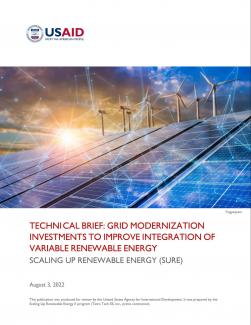Grid Modernization Investments To Improve Integration Of Variable Renewable Energy
Scaling Up Renewable Energy (SURE)
Technical Brief –
This technical brief can serve as a blueprint for where to start building understanding, support, and buy-in from policymakers and investors on grid modernization investments.
As prices for clean energy and storage technologies continue to fall and nations explore ways to cut emissions, integrating higher shares of variable renewable energy (VRE) is becoming more urgent. Experts and policymakers around the world understand that this complex task requires a more flexible power system, and flexibility requires a modern grid.
A “modern” grid is one that is larger, faster, and smarter – enabling VRE to be predictable, visible, and controllable. By making upgrades to modernize the grid, electricity network companies (utilities and transmission operators and owners) can detect network problems, assess data to inform grid decision making with fewer errors and faster analysis, and anticipate problems. It also enables large-scale renewables which are vital to achieving net-zero emissions. A modern grid also facilitates the adoption of flexible resources such as ramping hydro, peaking plants, and demand-side management which help balance the intermittency of VRE.
Modernizing the grid is a crucial step to unlock the full potential of renewable energy sources while ensuring a reliable and resilient power system. It requires updated policies and regulations, strong power markets, and new operational and commercial practices. It also requires important investments in equipment, systems, and software. This technical brief examines the types and sequence of investments required to manage the flexibility needed for successful grid integration of renewables.
Investments To Enhance Flexibility And Enable VRE Integration
Transmission and distribution grids require specific capabilities to measure and manage sources of flexibility, but there is no single “correct” architecture and implementation is country dependent. However, all modern grids are composed of three building blocks:
- Intelligent electronic devices that replace old “electromechanical” equipment and allow remote visualization and control of many parts of the power system.
- A modern control center where the people in charge of managing the grid go to work every day. These modern control centers rely on screens and computers instead of printed documents and telephones. This is where all the data from the intelligent electronic devices is received and processed, using computer software that processes information faster and better than humans and sends instructions back to the remote controls.
- Two-way communication network that carries signals back and forth between the intelligent electronic devices and the control center.
Adoption of the systems and technologies described above can be a complex process. Careful planning and a stepwise implementation program, such as the one mapped in this technical brief, are the keys to success.
A Framework for Grid Investments
In this technical brief USAID’s Scaling Up Renewable Energy (SURE) program presents a framework that clarifies the grid modernization process by visually mapping the types and sequence of investments required. SURE then applies this framework to three country examples: Colombia, Kazakhstan, and India. The three examples feature different flexibility needs and stages of grid modernization, shedding light on the key components and common traits across countries. Ultimately, this framework could serve as a blueprint for where to start building understanding, support, and buy-in from policymakers and investors on grid modernization investments.

